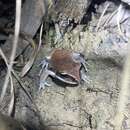fr
noms dans le fil d’Ariane


The green-thighed frog (Nyctimystes brevipalmatus) is a species of tree frog in the subfamily Pelodryadinae. Members of this species are medium-sized, ground-dwelling frogs, and are found in Australia.
The green-thighed frog is native to the east coast of Australia. Its range stretches from Cordalba State Forest in south-eastern Queensland to Ourimbah in New South Wales; within this area, though, populations are severely fragmented. The several records from Darkes Forest, south of Sydney, are erroneous. Numbers have decreased at Ourimbah, but there have been no record of declines or disappearances elsewhere. They are believed to occupy an area of less than 500 km2; this has led to them being listed as endangered on the IUCN RedList of Threatened Species
The dorsal surface is chocolate brown with darker flecks. The ventral surface is white or pale yellow and peppered with fine dark spots over the throat. A thick stripe runs from the snout, across the eye and tympanum, and then breaks up into blotches on the sides. The margin of the upper jaw is marked with white; this stripe continues to the base of the arm. The armpits are marked with lime green or yellow. The backs of the thighs and groin are bright blue, green, or blue-green, with black mottling. The tympanum is distinct, and finger and toe pads are medium-sized. The fingers don't web and the toes are one-third webbed. The iris is dark brown with a golden crescent in the upper half. The legs are shorter compared to other ground-dwelling hylids.
It inhabits areas of rainforest, wet sclerophyll, and open forests. Breeding occurs from September to May after heavy rain. From 300 to 600 eggs are deposited in temporary pools and flooded areas, and are laid in clumps among water weeds at the water's surface.
Green-thighed frogs are unlikely to be confused with any other species because of the bright colours in the groin and on the thighs and the lack of toe webbing.
The green-thighed frog (Nyctimystes brevipalmatus) is a species of tree frog in the subfamily Pelodryadinae. Members of this species are medium-sized, ground-dwelling frogs, and are found in Australia.
Nyctimystes brevipalmatus es una especie de anfibio anuro de la familia Pelodryadidae. Esta rana se distribuye por el este de Australia, desde el sudeste de Queensland hasta Ourimbah en Nueva Gales del Sur.[1][3]
Es de color marrón con una banda negra que va desde su boca a la pata delantera. Sus muslos e ingle son de color azul claro o verde con manchas negras en la ingle.[3]
Viven cerca de cuerpos de agua estacionales junto a zonas de bosque.[3] Pone entre 500 y 600 huevos en grupos que flotan sobre el agua. En condiciones experimentales los renacuajos tardan en realizar la metamorfosis y convertirse en ranas entre 52 y 100 días. En la naturaleza este proceso puede tardar menos, entre 34 y 42 días.[1][4]
Según la Lista Roja de la UICN, estas ranas están en peligro de extinción a causa de la deforestación, de la construcción de carreteras y ferrocarriles, de los incendios, de la contaminación, y también debido a la competición con especies invasoras.[1]
Nyctimystes brevipalmatus es una especie de anfibio anuro de la familia Pelodryadidae. Esta rana se distribuye por el este de Australia, desde el sudeste de Queensland hasta Ourimbah en Nueva Gales del Sur.
Es de color marrón con una banda negra que va desde su boca a la pata delantera. Sus muslos e ingle son de color azul claro o verde con manchas negras en la ingle.
Viven cerca de cuerpos de agua estacionales junto a zonas de bosque. Pone entre 500 y 600 huevos en grupos que flotan sobre el agua. En condiciones experimentales los renacuajos tardan en realizar la metamorfosis y convertirse en ranas entre 52 y 100 días. En la naturaleza este proceso puede tardar menos, entre 34 y 42 días.
Según la Lista Roja de la UICN, estas ranas están en peligro de extinción a causa de la deforestación, de la construcción de carreteras y ferrocarriles, de los incendios, de la contaminación, y también debido a la competición con especies invasoras.
Litoria brevipalmata Litoria generoko animalia da. Anfibioen barruko Hylidae familian sailkatuta dago, Anura ordenan.
Nyctimystes brevipalmatus est une espèce d'amphibiens de la famille des Pelodryadidae[1].
Cette espèce est endémique d'Australie[1]. Elle se rencontre de la forêt d'État de Cordalba dans le sud-est du Queensland jusqu'à Ourimbah à environ 80 km au Nord de Sydney en Nouvelle-Galles du Sud entre le niveau de la mer et 150 m d'altitude. La zone d'occupation est inférieure à 500 km2 étendue sur 72 500 km2[2].
Le mâle holotype mesure 41,0 mm et les femelles de 45,2 à 47,4 mm[3].
Nyctimystes brevipalmatus est une espèce d'amphibiens de la famille des Pelodryadidae.
Litoria brevipalmata é uma espécie de anfíbio anuro da família Hylidae.[2][3] É considerada em perigo pela Lista Vermelha da UICN.[1] Está presente em Austrália.[3]
Litoria brevipalmata é uma espécie de anfíbio anuro da família Hylidae. É considerada em perigo pela Lista Vermelha da UICN. Está presente em Austrália.